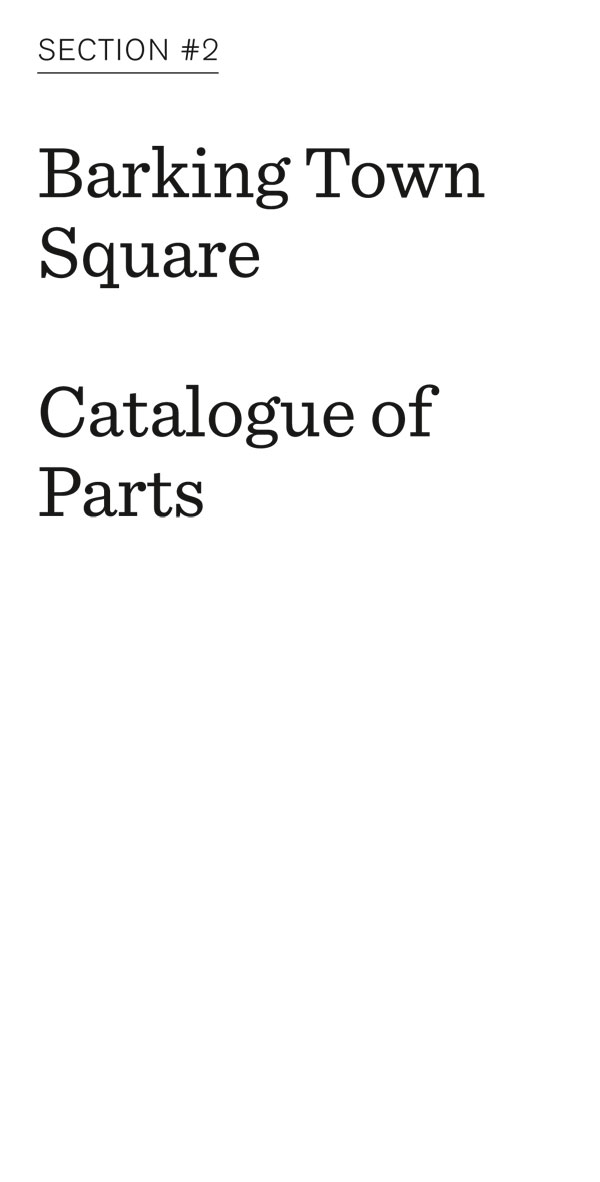
The design code covers the whole town centre of Barking and sets out the material palette and generic details at the scale of the macro, from raised tables and radius kerb edges to the micro, the joints between materials. The code is the council’s tool for subsequent design guidance and
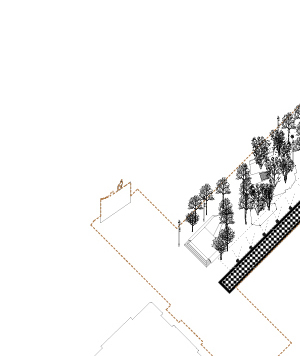
maintenance to ensure there is a continuity and coherence of design. The code highlights the tension in much of muf’s work between the bespoke designed for the specific and the desire of the client for a general solution that can be applied to any situation – the Strategy (s) element of Kath Shonfield’s muf equation: d/s=D, but without the resolution in D.
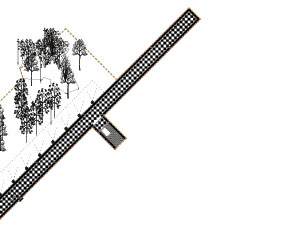
fig. 7 – Site plan
The square in front of the town hall is conceived as a huge outdoor room scaled to the larger-than-life dimensions of the civic, dense with the largesse of possibilities and inspired by archival drawings of the town hall that illustrate the spatial flexibility when chairs are rearranged (see fig. 8) – from debating chamber to transform into a wrestling ring or theatre. In contrast to the density of objects in the arboretum, the civic square is conceived as an empty room, a flexible space that can be programmed for activities generated by the institutions that flank it and other one-off events.
The paving consists of 200 mm strips of flamed pink Spanish granite in random lengths; larger pieces of granite mark the threshold to the new library building. The granite paving is extended to the north across a public access road to enlarge the square, making it a T-shape in plan, rather than an L. The pink hue of the flamed Spanish granite mediates between the red brick of the town hall facade and the shiny white new library and contrasts with the grey granite used elsewhere in Barking.
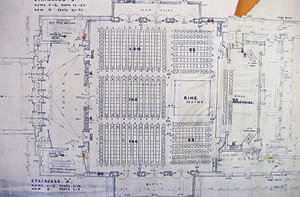
fig. 8 – Plan of the Town Hall, showing the
Council Chamber set out for a wrestling match
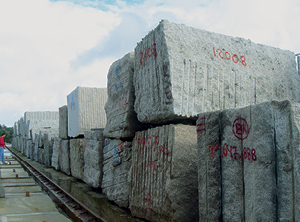
fig. 9 – muf argued on ethical grounds against procuring Chinese granite for reasons of carbon footprint and controversial labour practices. This proposal was embraced by Barking and has now become policy.
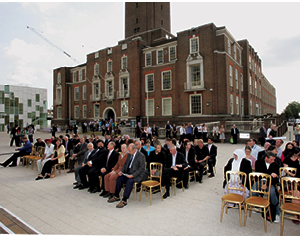
fig. 10 – The Civic square
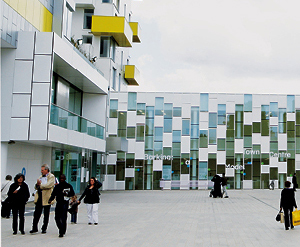
fig. 11 – The Civic square
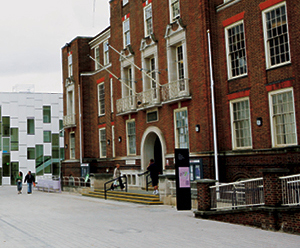
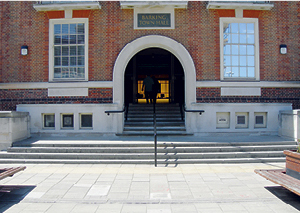
fig. 12 – Town hall steps
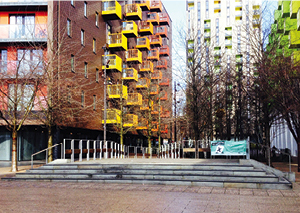
fig. 13– Steps to the arboretum
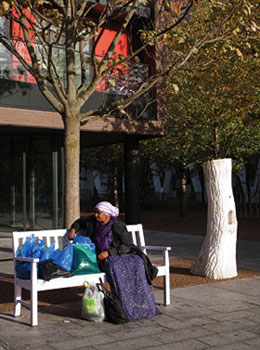
LBBD were lobbied by the Asbestos Victim Support Group of Barking Dagenham to have a memorial installed in the square. Since the only thing that alleviates asbestos poisoning is water, muf proposed a bespoke memorial drinking fountain in the form of a tree trunk carved from Portland stone. The water fountain is an extension of the arboretum. It makes a spatial connection to the folly wall and constitutes a transition between the two. It was erected with support from The Metropolitan Drinking Fountain and Cattle Trough Association.
The colonnade as the route from the town hall steps to Ripple Road, Barking’s main shopping street, was established through a design dialogue with the architects AHMM where muf proposed pulling back the façade of the two lowest floors of the library building to make a covered route.
This 80-m long, and 8-m high route is enclosed and separated from the arboretum by diagonal columns and is paved with black and white terrazzo tiles. Standard black and white 300 mm square paving tiles are grouped in diamonds each composed of 9 tiles. The pattern and layout of the terrazzo makes a ‘welcome mat’ out into Ripple Road and the regular diamond pattern inflects to mark the entrances to the private flats above, the public amenities of the library and the one-stop-shop, giving them equal status.
The terrazzo paving tiles refer to the grandeur of urban arcades and to the paths leading up to London’s Edwardian villas,
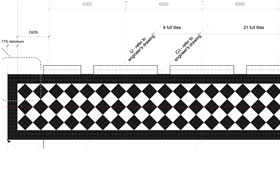
so even the prosaic act of renewing a parking permit becomes a ceremonial activity.
The arcade is lit by 13 large golden chandeliers, which fill the lofty space with light and suggest the glamour of a ballroom. They were designed in collaboration with British product designer Tom Dixon and electronics company Philips. They area hybrid design made for an interior fitting by Hiroki Takada, which has been magnified by 3 and adapted to its external location. The scale and scale of the floor tiles bring down the sense of the height of the roof.
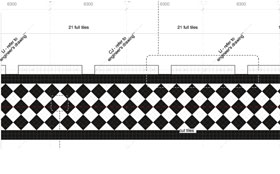
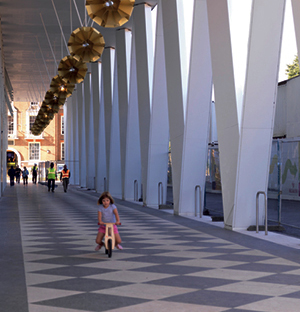
fig. 14 – Finished arcade
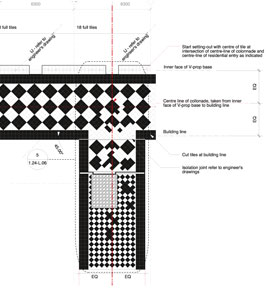
fig. 15 – Set out of terrazzo flooring
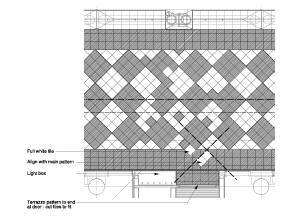
fig. 16 – Terrazzo detail
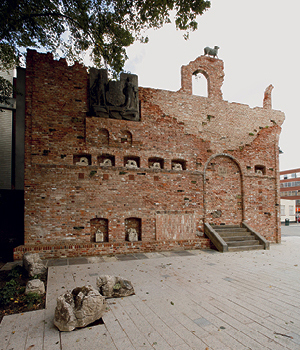
fig. 17 – The folly wall encloses the
civic square on its north side
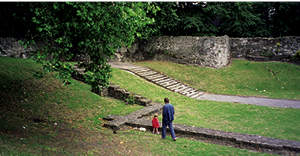
fig. 18 – The folly wall is designed as a reference to the ruins of the former royal monastery at Barking Abbey.
The folly wall was the result of an art commission to muf with an initial brief to work as artists on the design team with the architects Burns and Nice who were designing Clockhouse Avenue, the road leading up to the town square. muf expanded this brief as an opportunity to extend the design dialogue already initiated through the design of the town square.
The site on Clockhouse Avenue was one of the locations for the initial action research performance with the young people. From this activity, the construction of an alternative fantasy, muf conceived the wall. The wall is prosaic, it masks the back of house and service yard to the Iceland supermarket, it is strategic, it enlarges and creates the fourth elevation to the civic square and provides somewhere to sit in the sun and it is intentionally poetic.
The folly wall was designed as a ruin to refind what Barking was losing, a sense of its past, the wall references Barking Abbey and nearby Eastbury Manor and is composed of architectural salvage embedded in a brick thin skin that evokes not the truth of
its existence but recovers the texture of a lost historic fabric and stands as a memento mori to this current cycle of regeneration. In contrast to the homogenized visual environment of the factory made façade-panel skins of the new buildings surrounding the town square, the wall is entirely hand made, and was conceived as a means to recover construction skills that successive cycles of regeneration have eroded.
The detail design was established through test building with the local apprentice bricklayers and their masters at Barking College. A number of apprentices were taken on during the construction and the design continued as collaboration with bricklayer construction team – Shane, Steve, John and Arran from Excell Brickworks.
The build began with a visit to the Soane Museum with the Bricklayers for an archive tour of Soane’s documentation of the building of the Bank of England (Soane’s father was a bricklayer) The bricklayer’s inherent skills and experience of the limits and possibilities of the process transformed the collection of reclaimed pieces into a coherent whole.
The response of passers-by to the wall was documented by muf while on site during the build, people expressed a persistent belief that the wall had always been there, or had been reconstructed as a renovation from another site in the borough. The invisible support structure for the wall was achieved physically through engineering, and metaphorically through project management. Atelier One engineered the steel structure and method by which the brick skin is pinned to give it lateral stability. Peter Watson, the borough engineer, project managed, nurtured, inspired and protected the unconventional design and build process with the bricklayers.
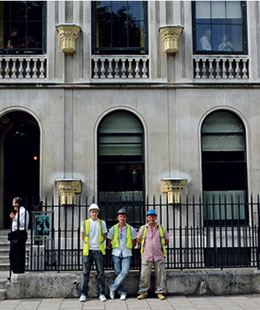
Soane’s father was a bricklayer, so we took the bricklayers to the Soane Museum in a stretch limo – it was a very weird journey. Collaborating artist Verity Keefe and I went too – stretch limos are very seedy and that was the first time we had met the bricklayers. As we drove through London they pointed out the things they had built, conscious that brick laying was being replaced by prefabricated brick skins. The curator of the Soane Museum gave them a guided tour and then showed them drawings and paintings of bricklayers building the Bank of England. It was a way to give real weight to their skill and set them up with a sense of their creativity and craft in what they were doing.
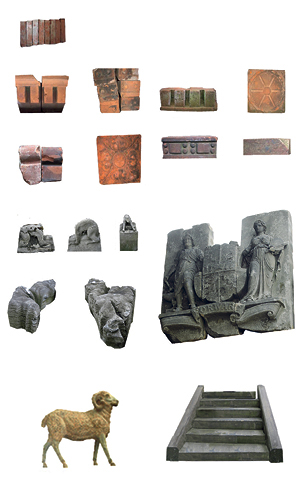
fig. 19 – Architectural salvage
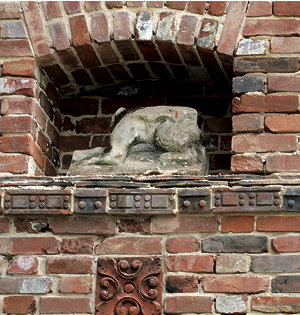
fig. 20 – Architectural salvage built into the wall
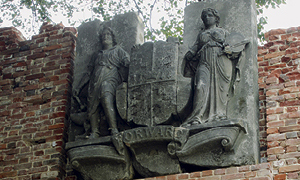
fig. 21 – Architectural salvage built into the wall
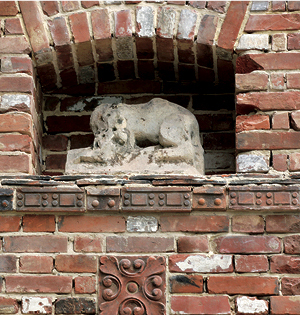
The arboretum derives from an image of nature as an escape and as otherworldly. It takes as its model the enchanted forest of Midsummer’s Nights Dream or Dear Brutus, where it is a site of liminality and transformation. It mirrors in depth the original council buildings its line of symmetry the steps.
Traditionally, an arboretum is a curated collection of specimen trees according to a specific theme. In Barking, the collection consists of 40 mature trees of 13 different species arranged to create settings of different scales and character. Key trees are selected in reference to texts held in the new library and make direct links to fictional situations in literature suggests a simultaneity of fiction and reality that is also present in the folly wall.
The tree species and varieties are as follows; where the arboretum meets the civic square cherry varieties create a year-round, white-flowering backdrop, with the arrangement of the trees forming a proscenium around the stage. The adjacent cluster is made up of pendulous swamp cypresses planted in and around an undulating
play structure, which has a dramatic intense orange-red autumn colour. Between these more formalized settings, are woodland ecologies of native multi-stemmed trees. These are planted with ground cover including translocated seeds from local ecologies such as Epping to give random accents.
Key desire lines criss-cross the space and between them the ground undulates, falling to create damp woodland ecologies and rising to create more formalized stages and promontories into the wooded areas. The arboretum embodies a potential for play (and recognizes adults and children as equal participants). Play is not ring-fenced but fostered through such devices as the miniaturization of street furniture, the transgression of boundaries to create intimate spaces, and high artifice, whereby casts of tree branches and of stacked tree trunks form balustrades and walls. The balustrades and cast log walls have references to Florentine details, such as the rails holding the tourists in the Piazza Della Signora at arms length, and the cast logs in the Barboli gardens which casually edge the paths.
The literary references are formalized in the outside reading room created by the
stage/steps that exactly mirror the steps leading up to the town hall and which link the arboretum to the adjacent Library and to the University of East London outpost. The decision to mirror the steps reflects an ambition to reconnect people, if only subliminally, to the political and social construction of democracy. The spaces beyond the stage mirror the town hall, as the scale of the arboretum is almost equivalent to that of its civic interior, its line of symmetry the steps (an exact surveyed ‘model’ of those at the entrance to the town hall).
The lighting is designed to accentuate the ephemeral quality of the trees. It has seasonal settings that respond to the changes in the colour of the trees and is directed through the canopies to create layered and shifting shadows on the ground. The same chandeliers are used as in the arcade, but here they reflect light rather than emit it.
The trees in the arboretum have come together as if from the Victorian Park, and this explicitly celebrates everyday specialness and luxury. But these parks were made for Sundays, the arboretum replays the proximity of the Georgian square – Royal Avenue moves east.
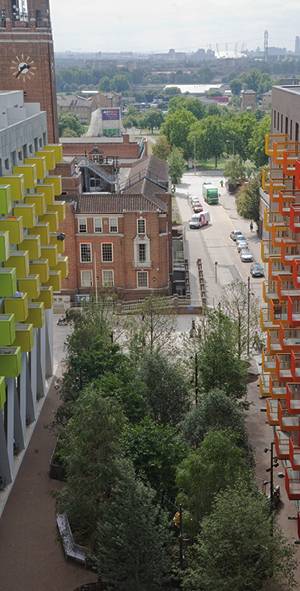
fig. 22 — The arboretum with its mature trees occupies the shadow space between the new buildings.
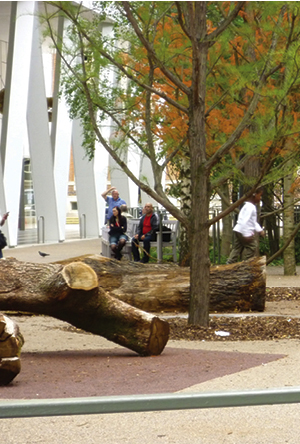
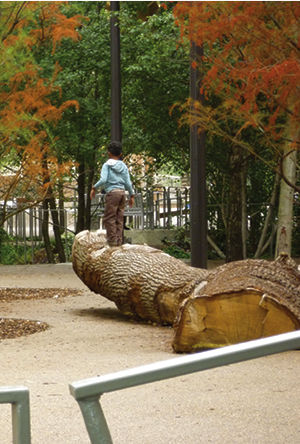
fig. 23 – Large tree trunks for play
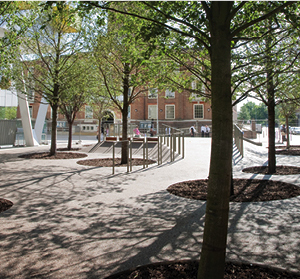
fig. 24 – Arboretum, stage and town hall
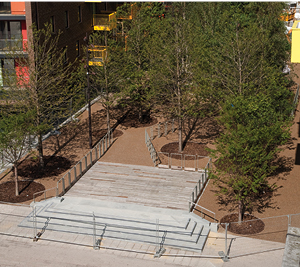
fig. 25 – Arboretum, stage and town hall
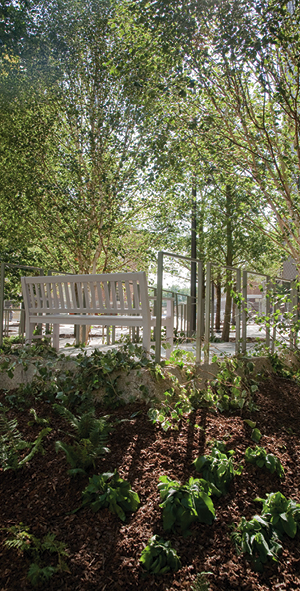
fig. 26 – The planting pits are sunken and enclosed
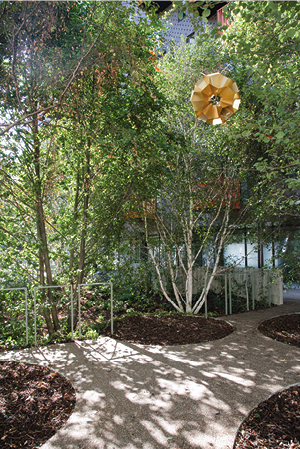
fig. 27 – Desire lines criss-cross the arboretum. The golden chandelier from the arcade is used also in the arboretum.
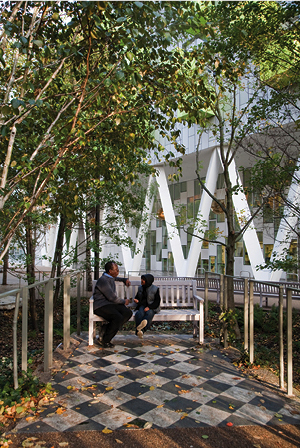
fig. 28 – The paving from the arcade is extended
into the arboretum
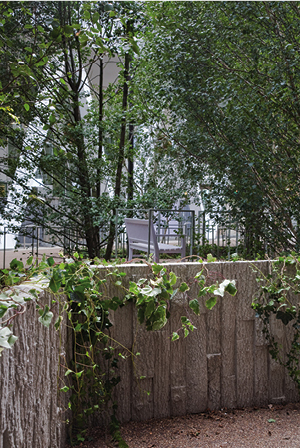
fig. 29 – Concrete tree trunk walls
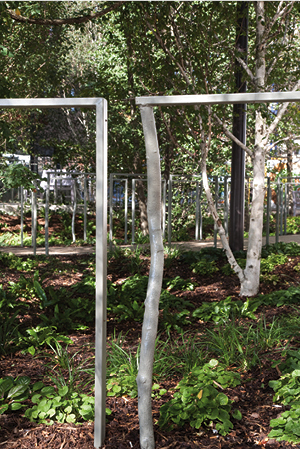
fig. 30 – Cast branches
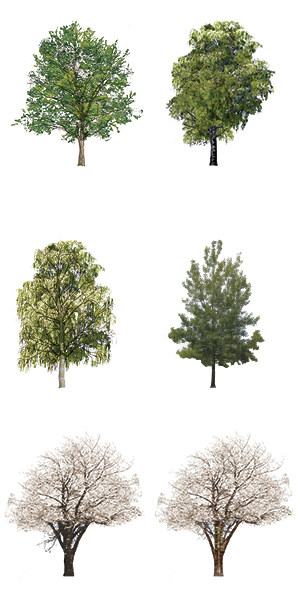
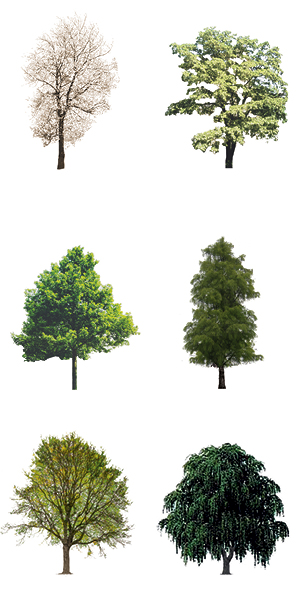
fig. 31 – Trees
Alnus glutinosa
Winter Alder
Betula nigra
River Birch
Prunus Avium
Wild cherry
Robinia Pseudoacacia
False Acacia
Betula Jaquemonti
Himalayan birch
Populus Tremula
Quaking aspen
Quercus Robur
Pin oak
Taxodium ascendens nuttans
Swamp cypress
Prunus Autumnalis
Winter flowering cherry
Prunus Serula
Tibetan cherry
Juglans Regia
Walnut Tree
Salix tristis
Willow
The Barking bench is a muf adaptation of a standard manufacturer’s product. The colour and the design of each bench is always specific to the location, for example, outside the health centre the bench has a stool for elevating and resting a leg, there are benches miniaturized to the scale of the child and benches that are extended in length to make more generous seating. This family of benches is part of the Barking code, and bespoke benches are situated outside the station and in the Short Blue Place Square.
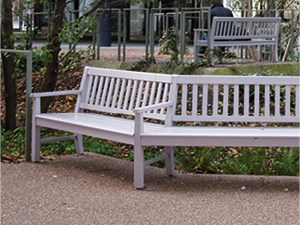
fig. 32 – Arboretum bench
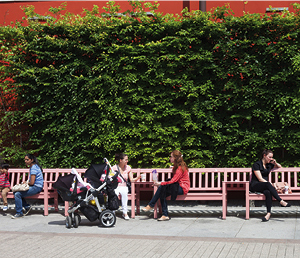
fig. 33 – Pink bench
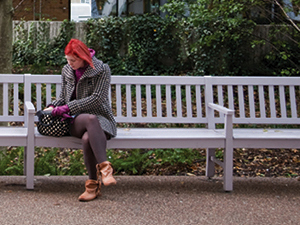
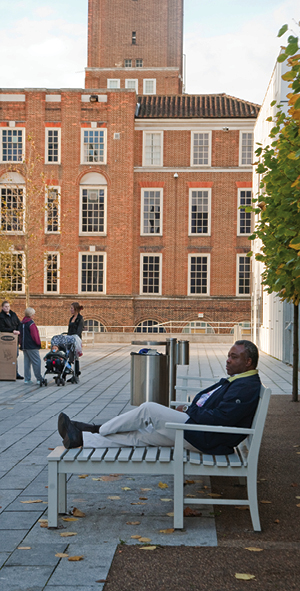
fig. 34 – Extended bench
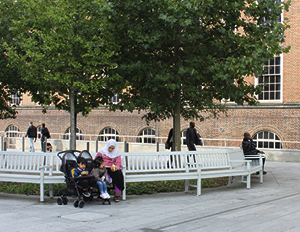
fig. 35 – Round bench
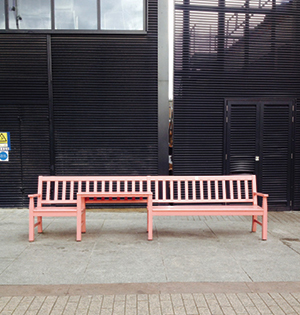
fig. 36 – Bench with table
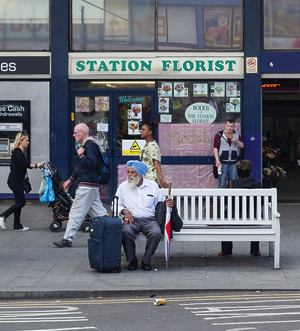
fig. 37 – Station parade, Barking